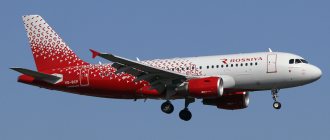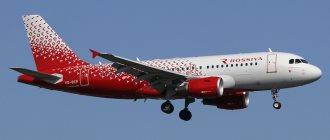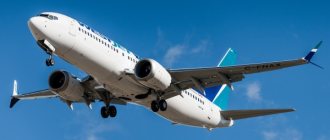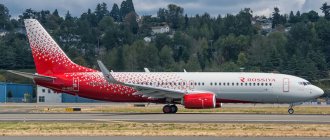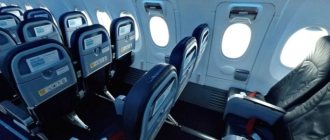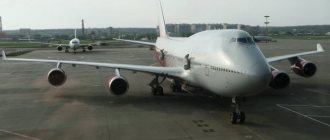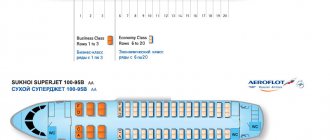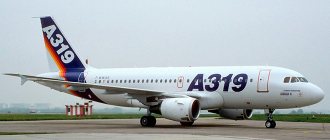| Technical specifications Interior diagrams Passenger reviews |
The Boeing 767–300 is a wide-body aircraft designed for long-haul and medium-haul flights. Produced by the American corporation The Boeing Company since 1981. In Russia, these liners are mainly used on charter flights departing to foreign resorts: Thailand, Vietnam, India (primarily Goa), Dominican Republic, etc.
Previously, Boeing 767-300 were used on regular international flights from Russia, but in 2014 - 2015, the airlines Aeroflot and Rossiya took them out of service.
Meanwhile, the Boeing 767-300 and its modifications continue to be used by such large foreign airlines as Delta Air Lines, Austrian Airlines, Air Canada, American Airlines, Air New Zealand, British Airways.
Technical characteristics of Boeing 767–300
Information from the website of the charter carrier Azur Air:
- Wingspan - 49 meters;
- Length - 55 meters;
- Cruising speed - 825 km/h;
- Flight range - 11070 km.
There are two aisles in the passenger compartment. There are 3-4 seats next to each other in the center, depending on the layout, and 2 seats on the sides, which is very convenient for those flying together.
Economy Class Boeing 767–300 of Japan Airlines © Altair78, CC BY-SA 4.0 on commons.wikimedia.org
Modifications
Boeing 767-300ER aircraft have an increased flight range (Extended Range) and passenger capacity. This modification is the most successful in this line, and is also used in Russia. Its main competitor is the Airbus A330-200.
Liners of the 767–300 °F modification are cargo.
Story
The development of an economical twin-engine jet airliner designed to serve medium- and short-haul routes began in 1978, when United Airlines expressed interest in a machine of this class and placed an order for the purchase of 30 aircraft at once. The first 767, still in Boeing's possession, was built and rolled out of the Everett, Washington plant on August 14, 1981, and made its first flight on September 26.
Development of the 767-400 began in September 1983. This model has a fuselage that is 6.5 meters longer than that of the 767-200, increasing the number of passengers by 22% (approximately 40 passengers) and the amount of cargo carried by 31%. The basic models were followed by variants with increased flight range.
Lower tier
The main cabin of the lower compartment starts from the 10th row. Seats from 10 to 11 lines are located in pairs, so the airline classifies them as an increased comfort class. Most often, tickets for these seats are purchased by families with children. On line 12, seats are arranged according to the 2:3 principle, and seats 12 with the designations “L”, “K”, “H” require increased payment.
In rows 14-16, the seats are arranged according to the classic 3:3 scheme, and in lines 17-19 - according to the 2:3:2 scheme. When choosing seats in these rows, it is worth noting that an additional payment is possible for seats 14 “A”, “B”, “C” and 17 “E”, “F”. Of course, these are comfortable, comfortable seats, but behind row 19 there are escape hatches. Consequently, the backrests of the seats in this row are not equipped with an adjustment function at all, which should be taken into account when reserving these seats.
For the same reason, it is not advisable to buy tickets for seats in rows 29, 43, 54, since it will not be possible to recline the seat due to the proximity of technical blocks, hatches and bathrooms. The flight experience can deteriorate sharply when choosing such seats in the cabin.
There are restrooms near the seats in rows 20-22 (“D”, “E”, “G”, “A”, “B” and “C”), which will not bring pleasure to tourists from the flight. But seats “D”, “E”, “G”, “H” and “K” in sector 29 are located near the emergency exit - you have to pay extra for them, but there is a lot of space around them, which will allow you to sit comfortably. And being closer to the emergency exit during an emergency is an added bonus. Also, seats “D”, “E”, “G” and “F”, located on line 23, would be a good choice.
The next block begins from row 31. Here, the blocking of the backrests and the close location of the bathroom can be called an inconvenience. There are also stairs and hatches nearby, but all the negativity can be compensated by the large space nearby. But the only seat in this row has a curved seat (very uncomfortable) due to being located near the emergency exit. It is uncomfortable, although there is a lot of space around.
The best choices are chairs “D”, “E”, “G” and “F”. They are quite comfortable, but in front of them there is a staircase along which people will constantly go up/down. And the seats in rows 32-34 are located near the bathroom, so people in those seats constantly complain about the noise. It is unlikely that you will be able to sleep there.
It is also undesirable to choose seats on lines 43, 54, 70 and 71. Due to the location of the emergency exit, the backrests on these seats cannot be adjusted, which causes discomfort during the flight. Rows 44 and 55 are also located near the toilet, but this disadvantage is compensated by more legroom. If you choose seats at the very end of the cabin, you should take into account that there is a restroom and service rooms there. Naturally, the backrests will not recline either.
Despite the fact that the Boeing 747 cabin capacity is huge, the designers were unable to create the same conditions for everyone to fly. Even seats for the same price can vary greatly in terms of comfort and convenience during the flight.
Travel tips
When purchasing a ticket on the airline’s official website, you can find the necessary form to familiarize yourself with the layout of this board. If you wish, you can call the airline manager, who will not refuse to help you choose a suitable seat. It is advisable to notify the employee of personal preferences and desire to sit, for example, near the window.
You should not buy a ticket for a seat that is located near the service premises. Usually, queues form near such premises and people are constantly moving, which creates unnecessary noise.
It is necessary to reserve seats where you can recline your back and stretch your legs - this is very important during a long flight.
A very bad option is to book a seat next to the partition. And if the flight is planned for the morning or in good weather, then it is advisable to reserve a seat near the window in order to enjoy the scenery outside the window during the flight.
Considering how large the capacity of the Boeing 747 aircraft is, the layout of the seats on the airliner needs to be studied in more detail. There you can determine better zones and places, the location of technical blocks, restrooms. Try to choose a place away from these premises. Remember that this may determine your overall flight experience. In addition, good conditions are especially important for people who are afraid to fly. After all, comfort reduces passenger stress and nervous tension. After a flight, a person can get off the plane full of energy, or he can be severely exhausted by the constant noise.
Indeed, the passenger capacity of the Boeing 747 allows this aircraft to be used on the busiest flights. The carrier does its best to ensure that its boards are filled with people as much as possible, so you should not count on the fact that the plane will be half empty and you will be able to take any seat. This happens extremely rarely with huge liners of this level.
Literature
- Becher, Thomas.
Boeing 757 and 767 (unspecified). - Marlborough, Wiltshire: Crowood Press, 1999. - ISBN 1-86126-197-7. - Birtles, Philip.
Modern Civil Aircraft: 6, Boeing 757/767/777.
3rd ed.
(English). - London: Ian Allen Publishing, 1999. - ISBN 0-7110-2665-3. - Davies, REG (2000), TWA: an airline and its aircraft
, McLean, Virginia: Paladwr Press, ISBN 1-888962-16-X - The Complete Encyclopedia of World Aircraft / Donald, David. - New York, NY: Barnes & Noble Books, 1997. - ISBN 0-7607-0592-5.
- Eden, Paul.
Civil Aircraft Today: The World's Most Successful Commercial Aircraft. - Silverdale, Washington: Amber Books Ltd, 2008. - ISBN 1-84509-324-0. - Frawley, Gerard (2001), The International Directory of Civil Aircraft
, Weston Creek, Australian Capital Territory: Aerospace Publications, ISBN 1-875671-52-8 - Haenggi, Michael.
767 Transatlantic Titan.
“Boeing Widebodies” series
(undefined). - Osceola, Wisconsin: Motorbooks International (English) Russian, 2003. - ISBN 0-7603-0842-X. - Kane, Robert M. (2003), Air Transportation 1903–2003.
14th ed.'
, Dubuque, Iowa: Kendall Hunt Publishing, ISBN 978-0-7872-8881-5 - Norris, Guy & Wagner, Mark (1996), Boeing Jetliners
, Osceola, Wisconsin: MBI Publishing, ISBN 0-7603-0034-8 - Norris, Guy & Wagner, Mark (1998), Boeing
, Osceola, Wisconsin: MBI Publishing, ISBN 0-7603-0497-1 - Norris, Guy & Wagner, Mark (1999), 767: Stretching and Growing, Modern Boeing Jetliners
, Osceola, Wisconsin: Zenith Imprint, ISBN 0-7603-0717-2 - Norris, Guy & Wagner, Mark (2001), Boeing 777, The Technological Marvel
, Osceola, Wisconsin: Zenith Press, ISBN 0-7603-0890-X - Norris, Guy & Wagner, Mark (2009), Boeing 787 Dreamliner
, Osceola, Wisconsin: Zenith Press, ISBN 978-0-7603-2815-6 - Shaw, Robbie.
Boeing 757 & 767, Medium Twins (undefined). - Reading, Pennsylvania: Osprey Publishing, 1999. - ISBN 1-85532-903-4. - Smil, Vaclav.
Transforming the Twentieth Century: Technical Innovations and Their Consequences. - Oxford, Oxfordshire: Oxford University Press, 1998. - ISBN 0-19-516875-5. - Sutter, Joe (English)Russian.
747: Creating the World's First Jumbo Jet and Other Adventures from a Life in Aviation (English). - Washington, DC: Smithsonian Books, 2006. - ISBN 0-06-088241-7. - Jane's All the World's Aircraft 1989–90 (unspecified) / Taylor, John WR. - London: Jane's Yearbooks, 1989. - ISBN 0-7106-0896-9.
- Wells, Alexander T. & Rodrigues, Clarence C. (2004), Commercial Aviation Safety
, New York, NY: McGraw-Hill Professional, ISBN 0-07-141742-7 - Wilson, Stewart.
Ansett: The Story of the Rise and Fall of Ansett, 1936–2002. - Weston Creek, Australian Capital Territory: Aerospace Publications, 2002. - ISBN 978-1-875671-57-1.
Upper tier
Considering the huge capacity of the Boeing 747 400, it is possible to arrange comfort and economy class seats in the cabin. The best ones are always on the top deck. The first lines are reserved for passengers with business class tickets, and a little further (rows 5-9) there are less comfortable seats for customers who prefer an economical flight. However, in any case, seats on the upper deck are more expensive than those on the lower deck. Note that the seats in business class are paired, each of them is made taking into account ergonomic criteria, so you can truly relax here. These chairs are quite wide, the backs recline, there are displays, and the distance between the sectors is quite large. For all these benefits, passengers are willing to pay extra, and quite a bit.
The seats in the very first row especially stand out, because there is a lot of space in front of these seats. The disadvantage is the location in the immediate vicinity of the bathroom; all passengers will pass through these places to get to it.
From the fifth to the ninth lines there are comfortable economy class seats. The most comfortable seats are on the fifth line, as there is a lot of legroom due to the large distance to the screen that separates business class. This sector has displays in the seats, a tilting function is available on the backrests, and the free space between the seats is 75 cm.
There are standard seats in rows 6-9, but passengers planning a flight are strictly not recommended to choose seats in the ninth row. Behind the back of these seats there is a staircase and a bathroom, which can cause inconvenience during the flight.
Accidents and incidents
Throughout history, 12 Boeing 767
of 967 built. One of the famous Boeing 767s was the so-called “Gimli Glider” - an aircraft that flew absolutely without fuel for more than twenty kilometers and made a completely successful landing, during which no one was seriously injured, and the aircraft received minor damage and was subsequently restored for further operation ( just two days after the repairs were carried out on site, I was able to fly away under my own power).
On September 11, 2001, during the attack on the World Trade Center and the Pentagon, two Boeing 767s were hijacked by terrorists and sent to the World Trade Center towers.
On November 1, 2011, a Boeing 767 of LOT airlines (tail number SP-LPC), en route from New York to Warsaw, made an emergency belly landing at Frederic Chopin Airport (Warsaw, Poland) due to the fact that the airliner did not have Not a single landing gear came out. None of the 230 passengers on board were injured.
| date | Board number | Disaster site | Victims | Short description |
| 02.91 | 9K-AIB | Mosul | 0/0 | Captured from Kuwait, destroyed during Desert Storm |
| 02.91 | 9K-AIC | Mosul | 0/0 | Captured from Kuwait, destroyed during Desert Storm |
| 26.05.91 | OE-LAV | east of thailand | 223/223 | Fell from the train. The left engine switched to reverse |
| 06.04.93 | N767TA | Guatemala | 0/236 | Flew off the runway while landing at high speed |
| 23.11.96 | ET-AIZ | Comoros | 125/175 | Flight Addis Ababa - Nairobi hijacked by terrorists who demanded to fly to Australia. Having run out of fuel, the plane made an emergency landing 500 m off the coast of one of the Comoros islands. |
| 31.10.99 | SU-GAP | Atlantic Ocean | 217/217 | Flight New York - Cairo. While the PIC was going to the toilet, the co-pilot, who had previously received disciplinary sanctions, with the words “I trust in Allah,” turned off the engines and sent the plane into a dive. Egyptian authorities insist on the version of autopilot failure. |
| 22.09.00 | N654US | Philadelphia | 0/3 | During inspection after maintenance, the left engine exploded |
| 11.09.01 | N334AA | NY | 1530+92/92 | American Airlines Flight 11, Boston (Logan) - Los Angeles. Terrorists flew a plane to the north tower of the World Trade Center. |
| 11.09.01 | N612UA | NY | 612+65/65 | United Airlines Flight 175, Boston (Logan) - Los Angeles. Terrorists flew a plane to the south tower of the World Trade Center. |
| 15.04.02 | B-2552 | Busan | 129/166 | Crashed during landing due to crew errors |
| 26.06.02 | JA8254 | Shimojishima | 0/3 | Crashed during a training flight |
| 28.06.08 | N799AX | San Francisco | 0/2 | Fire on board a stationary aircraft. The car has been written off. |
